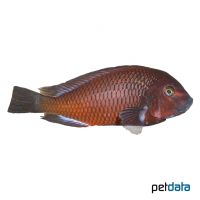Chimba-Moorii (Tropheus sp. 'Red Chimba')
| Chimba-Moorii Tropheus sp. 'Red Chimba' | |
|---|---|
| Name | Chimba-Moorii |
| Name Lat. | Tropheus sp. 'Red Chimba' |
| Family | Cichlids |
| Family lat. | Cichlidae |
| Order | Cichlids |
| Order lat. | Cichliformes |
| Origin | Lake Tanganyika |
| Habitat | Rocky shore |
| Diet | Limnivore |
| pH | 7.5-9.0 |
| Behavior | Semi-aggressive |
| Keeping | Group |
| Care Level | Moderate |
| Reproduction | Mouthbrooder |
| Breeding | Moderately difficult |
| Life Span | 5-8 years |
| Protection | No |
| Metric Units | |
| Size | 12 cm |
| Temperature | 24-28 °C |
| Hardness | 15-18 °dH |
| Aquarium | 150 cm / 370 l |
| US Units | |
| Size | 4.7" |
| Temperature | 75-82 °F |
| Hardness | 267-320 ppm |
| Aquarium | 100 gal |
Distribution and habitat
Tropheus are found exclusively (endemically) in Lake Tanganyika and are widespread seaward with many site variations. The Red Zambia Moori comes from the south coast near Cameron-Bay in Zambia. There it is found in the shallow shore areas with rocks and boulders.
Maintenance
The aquarium setup should have rock structures, with shelters, hiding places (crevices, caves) and open sandy areas, as well as plenty of swimming space.
No ammonia, ammonium and nitrite should be detectable, the nitrate value should not exceed 100 mg/l. To ensure the water quality and the oxygen content, a filter adapted to the aquarium size and a heater are required, as well as lighting for the species-appropriate day-night rhythm of the animals.
Diet
They eat the vegetable cover (growth) of stones and the microorganisms contained therein. The food supply consists of algae leaves, crushed peas, mashed leafy and wild vegetables, and dry food with vegetable components, such as kelp and spirulina. In addition, some live food, such as Artemia, Cyclops and Daphnia, which is also accepted in frozen form, supplemented with frozen special food mixtures.
Only feed as much as will be eaten within a few minutes. A regular and varied diet promotes health and increases resistance.
Behaviour and compatibility
They are very territorial within the species and should be kept singly or in a large group of 10-15 animals. It is recommended to put a group of juveniles into the aquarium at the same time. Thereby social structures are formed, which reduce territorial disputes. Group strangers are often fiercely fought. They should only be socialized with other cichlids from Lake Tanganyika. Basically, only compatible fish species with similar demands on water conditions and water temperature should be socialized.
Sex dimorphism
The sexes are difficult to distinguish. With some experience, the sexes can be determined by the shape of the genital papilla, which is pointed in the male and ends flat in the female.
Reproduction and breeding
They are maternal mouth brooders. Immediately after spawning on a rock, the females take the eggs, 5-15 of them, into their throat sac for mouthbrooding. They keep the fry in their throat sac even after hatching. After about 4 weeks, the fry are released, but are cared for another week before brood care ends.
Fry must be fed several times a day with special rearing food (Artemia nauplii). Breeding is hardly possible in community tanks, as the fry are easy prey.
Important
There are several site variants of Tropheus sp. 'Red', which differ in coloration and pattern. Different site variants should not be kept together, because they can crossbreed. However, they can be well socialized with other Tropheus species, which should differ in coloration
Red mosquito larvae should not be fed, as they can damage the digestive tract.
The well-being of the fish should be checked regularly. Temperature should be checked daily, pH, hardness and nitrate levels should be checked at least every 14 days. Regular partial water changes are recommended, even if the contaminant level has not yet reached the upper limit. Sudden changes in water quality should be avoided. Newly introduced fish must be accustomed slowly to the water in the aquarium.
Further literature can be found in your pet store.
References
Text: Werner Winter; Image: petdata
Source: BMELV (1998): Tierschutzgutachten - Haltung von Zierfischen (Süßwasser); RIEHL & BAENSCH (2006): Aquarien Atlas Bd. 1, Mergus Verlag; ENGELMANN (2005): Zootierhaltung - Tiere in menschlicher Obhut: Fische, Verlag Harri Deutsch
- Gemäß § 21 Abs. 5 Tierschutzgesetz idgF
